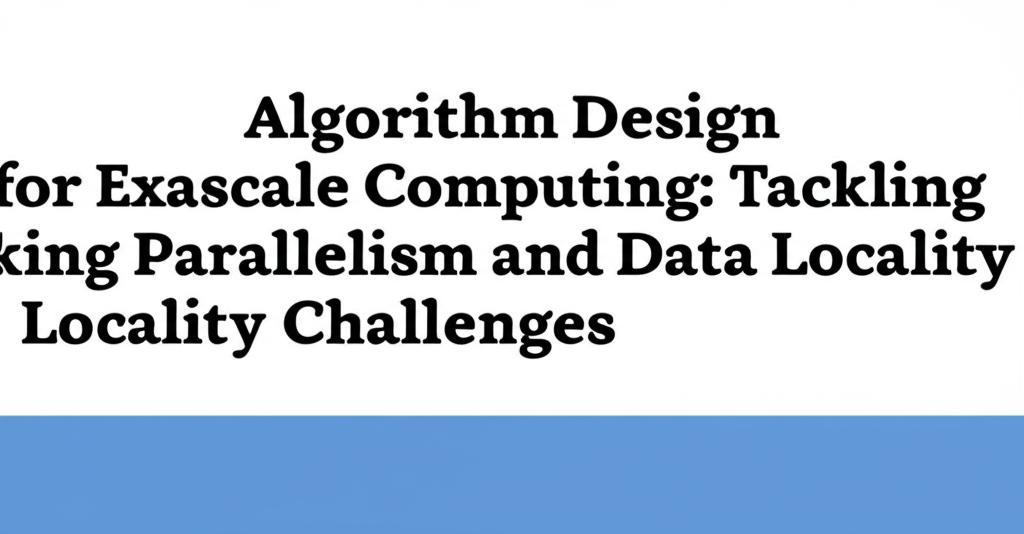Exascale computing marks a monumental leap in computational power, enabling simulations and data analyses at unprecedented scales. However, harnessing this power requires fundamentally rethinking algorithm design to overcome significant hurdles, primarily the Labyrinthine challenges of massive parallelism and data locality. As computing power increasingly outpaces memory speed and data movement capabilities, algorithms must evolve beyond simply minimizing calculations; they must prioritize minimizing data movement and effectively managing concurrency across millions of diverse processing units.
The Unprecedented Scale of ParallelismExascale systems feature millions of processing cores, often incorporating a mix of traditional CPUs and accelerators like GPUs. This extreme heterogeneity presents a major challenge: algorithms must efficiently distribute work and coordinate tasks across vastly different types of processing units, each with its own strengths, weaknesses, and memory spaces. Traditional parallel programming models, while still relevant, often need significant enhancements or complementary approaches to manage this complexity. Simply scaling up old algorithms is often untenable due to synchronization overheads and load balancing difficulties. Massive fine-grained parallelism is required, demanding new techniques to express and manage concurrent tasks effectively.
Data Locality: The New Performance BottleneckPerhaps the most critical shift in exascale algorithm design is the heightened focus on data locality. Moving data—whether between different levels of the memory hierarchy (cache, main memory, high-bandwidth memory) or between different nodes in the system—consumes significantly more time and energy than performing computations. Exascale systems exacerbate this with deep and complex memory hierarchies, including non-uniform memory access (NUMA) and separate memory spaces for accelerators. Algorithms must therefore be designed to maximize the use of data already resident in local memory or caches, minimizing costly data transfers. Failure to address data locality results in processors stalling, waiting for data, thereby negating the potential computational power.
Strategies for Algorithm DesignTo navigate these challenges, several key algorithmic strategies and programming paradigms are emerging:
- Communication-Avoiding Algorithms: These algorithms explicitly aim to minimize the total amount of data moved, both vertically within a node's memory hierarchy and horizontally between nodes. Techniques often involve restructuring computations to perform more local work, sometimes even using redundant computations to avoid communication steps. Examples include communication-avoiding LU factorization (CALU) and optimized matrix multiplication algorithms.
- Task-Based Programming Models and Runtimes: Frameworks like Legion, PaRSEC, Kokkos, and RAJA provide higher-level abstractions for expressing parallelism. They allow developers to define computations as tasks with dependencies. The runtime system then intelligently schedules these tasks onto available resources (CPUs, GPUs), managing data movement, load balancing, and exploiting potential task overlap, often hiding much of the underlying hardware complexity. These models are crucial for achieving performance portability across diverse exascale architectures.
- Explicit Data Layout and Placement Control: Recognizing the importance of data locality, programming models and libraries are providing more explicit control over where data resides. Partitioned Global Address Space (PGAS) models like UPC++ offer a shared memory abstraction while retaining awareness of data locality (local vs. remote), allowing programmers to optimize data placement. Libraries like SICM provide interfaces to manage complex, heterogeneous memory hierarchies. Techniques like array padding, merging, and transposing data structures are employed to optimize cache usage.
- Heterogeneity-Aware Algorithms: Algorithms must be designed, or adapted, to effectively utilize different types of processors simultaneously. This might involve partitioning algorithms so that computationally intensive, data-parallel sections run on GPUs, while control-flow-heavy or latency-sensitive parts run on CPUs. Achieving good performance often requires careful load balancing and minimizing data transfers between the different memory spaces.
- Asynchronous Execution: Overlapping communication with computation is essential to hide the latency of data movement. Algorithms and runtimes increasingly employ asynchronous communication patterns, allowing computation to proceed while data transfers occur in the background.
- Algorithm-Based Fault Tolerance (ABFT): With millions of components, failures become frequent events rather than exceptions. While historically addressed via checkpoint/restart, this method's overhead becomes prohibitive at exascale. ABFT techniques involve designing algorithms that can intrinsically detect and recover from errors, sometimes by incorporating redundant computations or data checksums, allowing them to continue execution despite faults.
Algorithm design for exascale computing necessitates a paradigm shift. The primary focus moves from merely minimizing floating-point operations to aggressively minimizing data movement and effectively managing massive, heterogeneous parallelism. Success hinges on developing and adopting communication-avoiding techniques, leveraging sophisticated task-based runtimes, consciously managing data locality across complex memory hierarchies, embracing heterogeneity, and building in resilience through fault-tolerant algorithmic approaches. Only through such holistic and data-centric algorithm design can the scientific potential of exascale systems be fully realized.

